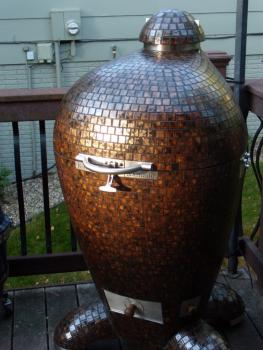Leaderboard
Popular Content
Showing content with the highest reputation on 08/24/2015 in all areas
-
This month has been a great one for vacation, but not so good for using Smaug. The first week of August we were away on vacation. The second week I was slammed at work because my colleagues were away on vacation. Last week I was at the Hole in the Wall Gang Camp, a camp for kids with cancer and blood diseases. I’m a pediatric oncologist, and I was there doing the volunteer doctor thing for the kids at camp. It’s a ton of fun, I’m happy to spend a week up there each summer, and my family gets to go with me. Our sons got to participate in the camp activities while I was working, which means my wife got to hang out while I was working in the infirmary. However, being away at camp means eating camp food (burgers, hotdogs, chicken nuggets) for meals, and when we got back yesterday, I was CRAVING something Chinese. So I decided to make a quick and dirty Peking duck for our first meal at home in a week, and my first real cook on Smaug since the first weekend of August. I picked up a duck from the local Chinese grocery store. They sell ducks with the head and feet still on, which is how you can tell that the duck is fresh, not frozen. The first step was to force air under the skin. I used a marinade injector with the blunt tip to do this as best as I could. I’ve seen videos where they use an air compressor for this task. Every time I try this with a duck, I get one step closer to getting an air compressor. Next, I boiled a pot of water, and submerged the duck for about 30 seconds. Having a duck with the head on is good, because it makes a nice handle. The boiling water shrinks the skin so that it tightens up. This helps get a crispy skin. I put a mixture of 2 Tbsp. five spice powder and 1 Tbsp. salt into the cavity. And on the outside I drizzled a mixture of 2 Tbsp. honey and 1 cup hot water to glaze the skin. Then I hung the duck outside to air dry as much as I could. Again, having the head on comes in handy here. This was the first quick and dirty part of this cook. Ideally, you let the duck air dry for 24 hours, or 8 hours if it’s windy. The idea is to dry out the skin so that it’s slightly leathery in consistency, which also leads to a crispy skin. Today I let it hang for about three hours. Once I was done letting the duck air dry as much as I could, I took off the head and feet, since they wouldn’t be needed for the roasting part. I placed the duck in the rotisserie basket with the 6†reducer. And put it into Smaug. You can’t see the charcoal basket, but I have the splitter in, oriented so that the splitter runs left to right, and the bottom half of the basket has charcoal in it. I didn’t use a deflector for this cook, so the duck gets direct exposure to heat half the time. This is how it finished up. The dome thermometer read 300ºF for most of the cook, and and the end the temperature rose to 350ºF. I pulled the duck off when I hit an IT of 170ºF in the thigh meat. Total cooking time was about 50 minutes. Here’s the glamour shot of the whole duck on a platter. Sliced breast meat. Here’s how I assembled the Peking duck for serving. Inside a thin pancake goes duck meat and skin, some green onions, and a sauce made from 1 Tbsp. hoisin sauce, slightly less than 1 Tbsp. sesame oil, and slightly less than 1 Tbsp. water. Tradition also calls for some julienned cucumber, but we didn’t have any. And the finished Peking duck wrap, with some stir-fried bok choy. Here’s one last thing I tried. Last year and two years before that, we traveled through China. On both trips we spent some time in Beijing, where there’s a restaurant called Sijiminfu that’s well known for its Peking duck. But saying that Sijiminfu is well known for its Peking duck is an understatement on the order of saying that a KK grill is a decent grill. Not only is the Peking duck at Sijiminfu better than any other Peking duck that I’ve ever had, all the other dishes that I had there were amazing. Even a basic stir-fried vegetable dish with oyster sauce was better than the same dish I’ve had elsewhere. We ate there four out of the five nights that we spent in Beijing last year, and I wish we had eaten there the fifth night as well. This is the sort of restaurant that I want to eat my last meal at. It’s that good. Anyway, besides the traditional Peking duck, Sijiminfu did some updates as to the stuff that goes into the wrap. There was this plum jam, a garlic paste, and minced pickled mushrooms that they provided for the wraps that were quite good, and that I couldn’t even begin to try to duplicate. But the one thing that I tried to duplicate was taking some duck skin (no meat here), and dipping it into some raw sugar. This is what it looks like right before I ate it. Success! This was quite close to what I remember eating last year at Sijiminfu. It was yummy. Try this some time. I still have some room for improvement for this sort of cook. Here are some things I need to tweak. First of all, the skin was mostly good, but there were some areas that were not as brown as I would have liked. There are several factors that could have led to this. The big one is the shortened air drying time. I don’t think there’s any good way of shortcutting this step. Second, although the marinade injector visibly inflated the duck skin, I know this step could have been done better. Like I said, every time I cook duck I get one step closer to getting an air compressor. Third, some of the lack of brown color could be from uneven application of the honey mixture. I need to pay more attention to this step next time. Fourth, if/when I go the rotisserie route again, I’m going to try it without the splitter, and aim for a lower temperature to start to try to render more fat out of the duck. Compared to Sijiminfu, I got out about 80% of the fat. The remaining fat didn’t make the duck too greasy, but it’s not the same as in the big leagues. As an aside, I was surprised that the temperature hovered at 300ºF for as long as it did. I was shooting for 350ºF on the dome thermometer. Some of that may be the fact that I’m using the splitter, but I did peek inside a couple of times to see what was happening. I think what was going on was that the duck fat hit the charcoal as it dripped away from the duck, which lowered the temperature of the fire. There was quite a lot of smoke coming out of the top vent. Once most of the duck fat had rendered, the fire got hotter, which lends support to my theory that the dripping fat was cooling off the fire. Finally, I’ve cooked duck in Smaug before on the main grate with the heat deflector. I think that the rotisserie overall gives me a better result, but I’m going to try both methods for a while before deciding.1 point
-
1 point
-
The girl is smart. Welcome to the KK forum! Now it’s just a matter of time before you place your order.1 point


